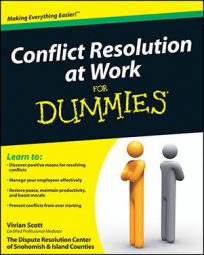After you've mediated an employee conflict, follow up with discussions to readdress issues and discuss new problems. Post-mediation discussions are also an opportunity to work through any glitches that are surfacing because of specific agreements made in previous meetings.
If the mediation or group facilitation agreement you’re monitoring calls for follow-up meetings, make sure that the events make their way to the participants’ calendars and that they’re seen as a priority.
Regardless of the attendees, the goals are always the same: to give the participants a chance to share how they think things are going and to create an opportunity for each person to address any new conflicts or concerns.
Setting up the follow-up meeting
Provide enough time between the mediation and a follow-up discussion for agreements to work or not. You know your employees, so you know what a reasonable amount of time is, but keep in mind that an employee needs a chance to try out a new method of speaking or implement a different process before you rush in to declare it’s just not working.
Let the participants know you’d like them to meet again by communicating the following:
Tell them whether the meeting is mandatory or voluntary.
The follow-up isn’t a punishment but rather an opportunity for both (or all) to discuss successes and retool what isn’t working.
The agreement document (if it exists) will be used as the agenda, but the participants can always add to it as needed.
Each employee should make notes on what is and isn’t working and come prepared with new proposals and an open mind.
You’re eager and available to help if, when, and where needed.
The participants are free to make adjustments to previous agreements.
Let the parties know that you’re paying attention and holding them accountable for follow-through.
Holding the follow-up meeting
Post-mediation meetings are different from formal mediations or group facilitations. For starters, there should be less tension in the room. The participants have already seen the value of the mediated process, and although things may not be going exactly as planned, there should be more common ground to discuss and perhaps even a few successes to celebrate.
Manage a successful post-mediation meeting by following these steps:
Deliver a more casual and abbreviated opening statement than the formal statements you used in the first mediation.
Start the discussion with what’s working.
Create an agenda that starts with the previous meeting’s agreement document (or participants’ recollection of the agreements) and anything new that needs to be added.
Use the agenda as a road map while you open the conversation up to the participants as a time for each of them to share what his experience has been since the first meeting.
Explore whether the co-workers are getting what they had hoped for by asking open-ended questions.
Keep an eye on their interaction, but remain at a distance until needed.
Schedule another meeting with an eye on the future.
There’s no hard and fast rule about the number of meetings needed, so it’s up to all involved to consider what’s in the best interest of the participants and the working environment as a whole.

